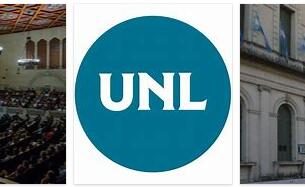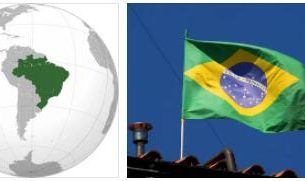There are a total of three countries that can be referred to as “Guyana”. These are French Guiana, Suriname (the former Dutch Guiana) and the cooperative Republic of Guyana presented below, the third smallest country in South America after Suriname and Uruguay, which lies between Brazil, Venezuela, Suriname and the Atlantic Ocean.
Guyana hit the headlines of the world in 1978 when the preacher Jim Jones (1931-1978) committed mass suicide in the jungle of Guyana with at least 900 members of his “Peoples Temple” sect, including 270 children.
The former “British Guiana” is a member of the Commonwealth of Nations and CARICOM, the “Caribbean Community and Common Market”, which is based in the capital of Guyana (Georgetown). The name of the former socialist state comes from Arawak and means something like “land of many waters.” And in fact, Guyana has many large and navigable rivers, the largest of which is the Essequibo, which rises in the country and extends to the north pours the Atlantic. The mighty rivers, to which the Demerara and Berbice also belong, are vital “roads” into the rainforest and form impressive waterfalls such as the Orinduik Falls, the Marshall Falls and of course the Kaieteur Falls in the Potaro National Park.
The rest of the country is determined on the one hand by a wide coastal plain, which largely disappears below sea level, and on the other hand by savannahs (Rupununi), which spread in southwestern Guyana. About 4/5 of the area of the small republic in northern South America is covered by the dense tropical rainforest, which is home to more than 700 native bird species. It stretches into the centrally located mountainous region, where the 2,875 meter high Roraima rises, the highest mountain in the country.
About 20% of the residents of Guyana are concentrated in the region around the capital Georgetown, which is the cultural and economic center of the country, but like the other cities in the country is anything but large. But it offers a special charm with its diversity, in which the most modern hotels contrast with magnificent colonial buildings. The city’s amazing wooden structures are reminiscent of the time when Guyana was first a Dutch and later a British colony.
The country is actually only inhabited in the coastal area. Isolated Indian tribes live in the highlands. The native residents of the country, the “Amerindians”, can be found almost only in the southwest of Guyana and are controlled by the chiefs or elders (captains). You can only legally get there with a permit from the Amerindian Affairs Office in Georgetown. The majority of the Guyans, however, have an Indian origin, which also explains why the culture of the state is determined in particular by Hindu and other Indian traditions and why Hindi is widely spoken in addition to Creole English.
The Guyanese economy that made its independence from Great Britain could only achieve in 1966, relies mainly on the export of sugar, gold, rice, bauxite and wood. Despite the incredible charm that the South American country exerts on many potential visitors because of its extraordinary natural beauty, it is not very well developed for tourism and is anything but safe. The crime rate in this country, which is one of the poorest countries in the world, is alarmingly high, which also applies to the gap between rich and poor. Many areas, such as the hinterland of Guyana, are controlled by the military, who first have to approve travel to areas where border disputes with Suriname and Venezuela have been going on for a long time.
| Name of the country | Cooperative Republic of Guyana |
| Form of government | Presidential Republic in the Commonweal |
| Geographical location | 30 ° 05 ‘to 34 ° 58’ south latitude and 53 ° 07 ‘to 58 ° 28’ west longitude |
| National anthem | “Dear Land of Guyana” |
| Population | 780,000 (Credit: Countryaah: Guyana Population) |
| Ethnicities | around 52% are of Indian descent, 30% African, 5% Indian and 10% mestizo or mulatto |
| Religions | about 30% Protestants, 30% Hindus, 25% Roman Catholics, 8% Muslims and natural religions as minorities |
| Languages | English is the official language, Hindi, Urdu, Creole and Indian languages such as Aruak are still spoken |
| Capital | Georgetown |
| Surface | 214,969 km² |
| Highest mountain | Roraima 2,810 m |
| Longest river | Essequibo 1,010 km |
| Largest lake | |
| International license plate | GUY |
| National currency | Guyana Dollar (G $) |
| Time difference to CET | – 5 h |
| International phone code/mobile network | + 592 |
| Mains voltage, frequency | 240 volts/60Hz |
| Internet TLD (Top Level Domain) | .gy |
Guyana: history
Before the year 1499
The Guyana region is believed to have been around since around 1,000 BC. been populated. Semi-settled Indians of the Warrau, Carib and Aruak tribes populated the country long before the arrival of the Spanish and Dutch.
European colonial period from 1499 to 1816
According to Abbreviationfinder website, the Spaniards discovered the country as early as 1499. However, they didn’t find it interesting as a colony. As a result, Dutch trading companies established bases on the coast of the country in the sixteenth century.
From the 17th century the interior of the country was populated by the Dutch, English and French. The Netherlands obtained the colony by ceding their rights in New Amsterdam (New York) to Great Britain.
In 1816 the region was divided. The colonial power France received the eastern part, the center, called Surinam, went to the Netherlands and the western part, today’s Guyana, became an English colony.
British colonial period from 1816 to 1966
In 1831, British Guyana became a British Crown Colony. Slavery was abolished by British administrators as early as 1834-1838. If the hard work on the sugar cane plantations was previously done by African slaves, this has now been done by guest workers from India and Portugal.
This economic change led to the immigration of 300,000 people within almost 100 years.
In 1892 the colony received some self-government rights. Venezuela has claimed two thirds (!) Of the territory of Guyana since 1895.
A new constitution made the parliamentary election of 1951 possible. The result was a left-wing government of the People’s Progressive Party (PPP) led by Cheddi Jagan, which, however, did not find approval in the mother country. As a result, Great Britain abolished the constitutional rights of citizens. When the constitution came into force again in 1957, the PPP had already split. The People’s National Congress (PNC) now represented the Afro-Guyanese population, while the PPP tended to represent the Indian population. Racial riots have been a recurring event ever since.
Independence since 1966 and until today
England gave the country independence in 1966. However, remaining in the Commonwealth stabilized the ties to the motherland.
In 1970 the republic was transformed into a “Cooperative Republic”. The ruling PNC sought socialism for the country. Parts of the economy were nationalized. The PNC was accused of forgery in elections. In 1980 the country received a new constitution. The republic was transformed into a socialist presidential republic.
The president was given more power. In the following years there was an economic crisis and under President Hugh Desmond Hoyte (1985-1992) the country was reopened to foreign capital and some socialist reforms reversed. The 1992 election was under observation by the UN. The People’s National Congress, which had ruled from 1964, lost power to the PPP for the first time. The economic data on average per capita income and foreign trade are sobering.
Jonestown
The country hit the headlines of the world when the preacher Jim Jones (1931-1978) drove around 900 members of the sect – including 270 children – to mass suicide in the Guyanese jungle on November 18, 1978. The sect named “Peoples Temple” was founded by Jones in 1956 in the USA was founded and initially lived according to a socialist and Christian belief in redemption. Since he saw no future for his sect in the USA, he moved with numerous members to Guyana in 1977. When he came into the sights of public investigations there, too, Jones, who had become more and more paranoid, saw only the way out in mass suicide, which was carried out with fruit drinks containing cyanide. However, many sect members were also murdered against their will.



